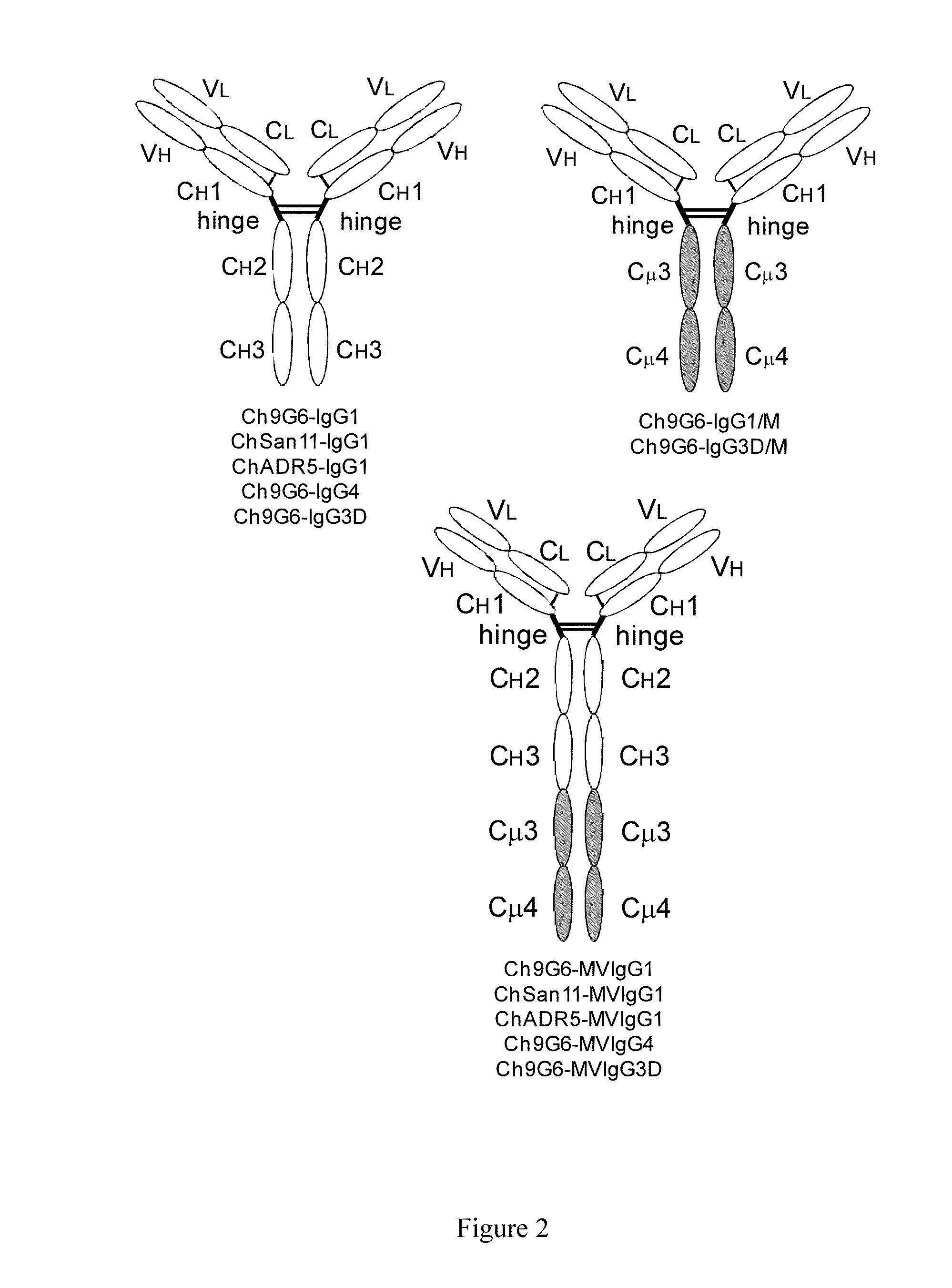Hybrid constant regions
a constant region and hybrid technology, applied in the field of glycoproteins, can solve the problems of long serum half-life, 23 days, and slow clearance of igg antibodies
- Summary
- Abstract
- Description
- Claims
- Application Information
AI Technical Summary
Benefits of technology
Problems solved by technology
Method used
Image
Examples
example 1
Expression Vectors
[0155]Gene cloning, mutagenesis and plasmid construction in this work was carried out with standard molecular biology techniques. See Sambrook and Russel (Molecular Cloning, A Laboratory Manual, 3rd ed., 2001, Cold Spring Harbor Laboratory Press, Cold Spring Harbor, N.Y.), Kostelny et al. (Int. J. Cancer 93:556-565, 2001), and Cole et al. (J. Immunol. 159:3613-3621, 1997), which are incorporated herein by references.
[0156]The mammalian expression vector pCh9G6-IgG1 (FIG. 1) for production of a chimeric IgG1 form of the mouse anti-human CD79a monoclonal antibody 9G6 (Ch9G6-IgG1) was constructed to contain the following genetic components. Proceeding clockwise from the SalI site of pCh9G6-IgG1 in FIG. 1, the plasmid contains the heavy chain transcription unit starting with the human cytomegalovirus (CMV) major immediate early promoter and enhancer (CMV-P in the figure) to initiate transcription of the antibody heavy chain gene. The CMV promoter is followed by the hea...
example 2
Expression, Purification and Characterization of Multivalent Anti-CD79a IgG1 Antibodies
[0172]The expression vectors pCh9G6-IgG1, pCh9G6-IgG1 / M and pCh9G6-MVIgG1 were introduced into the chromosome of a mouse myeloma cell line NS0 (European Collection of Animal Cell Cultures, Salisbury, Wiltshire, UK) to obtain cell lines stably producing Ch9G6-IgG1, Ch9G6-IgG1 / M and Ch9G6-MVIgG1 antibodies, respectively. NS0 cells were grown in DME medium containing 10% fetal bovine serum (FBS; HyClone, Logan, Utah) at 37° C. in a 7.5% CO2 incubator. Stable transfection into NS0 was carried out by electroporation as described in Bebbington et al. (Bio / Technology 10: 169-175, 1992). Before transfection, each expression vector was linearized using FspI. In a typical experiment, approximately 107 cells were transfected with 20 μg of linearized plasmid, suspended in DME medium containing 10% FBS, and plated into several 96-well plates. After 48 hr, selection media (DME medium containing 10% FBS, HT medi...
example 3
Apoptosis by Multivalent Anti-CD79a IgG1 Antibodies
[0177]The human Burkitt's lymphoma cell line Ramos expresses on the cell surface B cell receptors composed of membrane-bound IgM / lambda, CD79a and CD79b proteins (Ollila et al., Mol. Immunol. 44:3537-3551, 2007; Reth, Annu. Rev. Immunol. 10:97-121, 1992). Multimerization of B cell receptors by cross-linking is known to induce apoptosis of Ramos cells (Ollia et al., supra).
[0178]Ramos cells were grown in DME media containing 10% FBS. To assess the ability of Ch9G6-IgG1 and Ch9G6-MVIgG1 antibodies to multimerize B cell receptors on the cell surface via binding to CD79a proteins, resulting in induction of apoptosis, each antibody was incubated with Ramos cells in triplicate at a final concentration of 1 mg / ml. Ch9G6-IgG1 was also added at 1 mg / ml together with 10 mg / ml of goat anti-human IgG polyclonal antibody for cross-linking. As a positive control of apoptosis, 1 mg / ml goat anti-human lambda light chain polyclonal antibody was incu...
PUM
| Property | Measurement | Unit |
|---|---|---|
| pH | aaaaa | aaaaa |
| pH | aaaaa | aaaaa |
| density | aaaaa | aaaaa |
Abstract
Description
Claims
Application Information
 Login to View More
Login to View More - R&D
- Intellectual Property
- Life Sciences
- Materials
- Tech Scout
- Unparalleled Data Quality
- Higher Quality Content
- 60% Fewer Hallucinations
Browse by: Latest US Patents, China's latest patents, Technical Efficacy Thesaurus, Application Domain, Technology Topic, Popular Technical Reports.
© 2025 PatSnap. All rights reserved.Legal|Privacy policy|Modern Slavery Act Transparency Statement|Sitemap|About US| Contact US: help@patsnap.com



